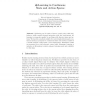909 search results - page 110 / 182 » Introduction to artificial neural networks |
AUSAI
1999
Springer
14 years 8 days ago
1999
Springer
Abstract. Q-learning can be used to learn a control policy that maximises a scalar reward through interaction with the environment. Qlearning is commonly applied to problems with d...
FLAIRS
2008
13 years 10 months ago
2008
This paper presents a strategy for shape-based image retrieval in which moment invariants form a feature vector to describe the shape of an object. Fuzzy k-means clustering is use...
CEC
2008
IEEE
13 years 10 months ago
2008
IEEE
This article presents results from experiments where a detector for defects in visual inspection images was learned from scratch by EANT2, a method for evolutionary reinforcement l...
ISMB
1994
13 years 9 months ago
1994
Adaptive resonance theory (ART)describes a class of artificial neural networkarchitectures that act as classification tools whichself-organize, workin realtime, and require no ret...
SIGDOC
2003
ACM
14 years 1 months ago
2003
ACM
Artificial intelligence techniques have found a number of applications in hypermedia, mostly in two specific areas, user interface, particularly adaptive ones and information sear...

